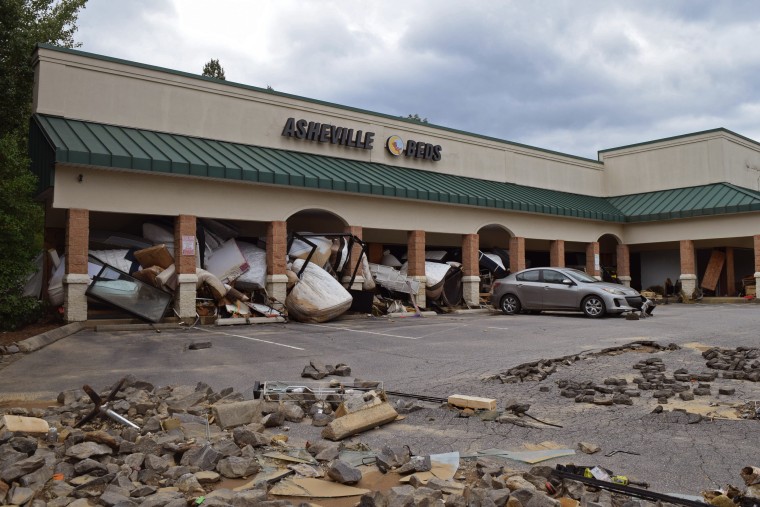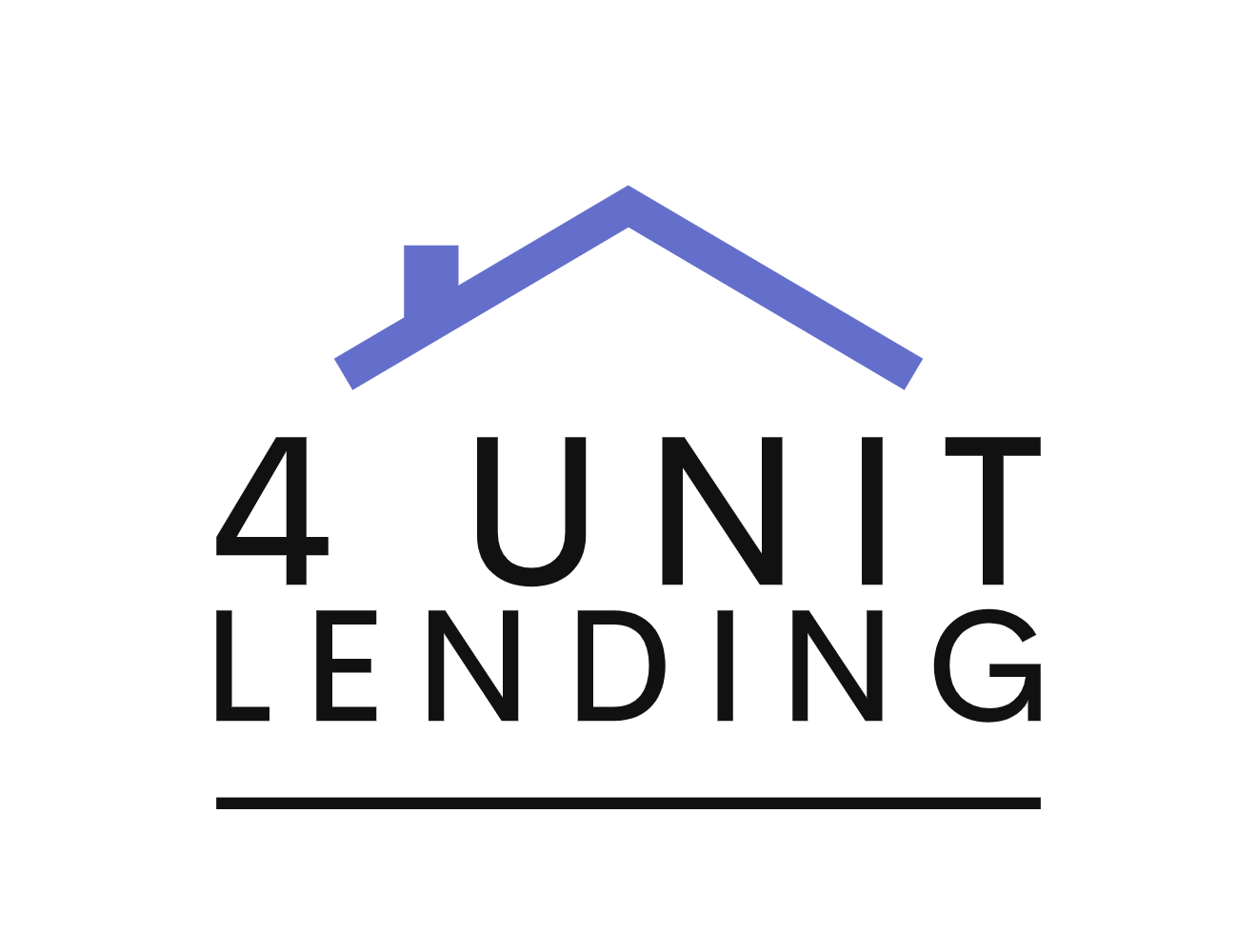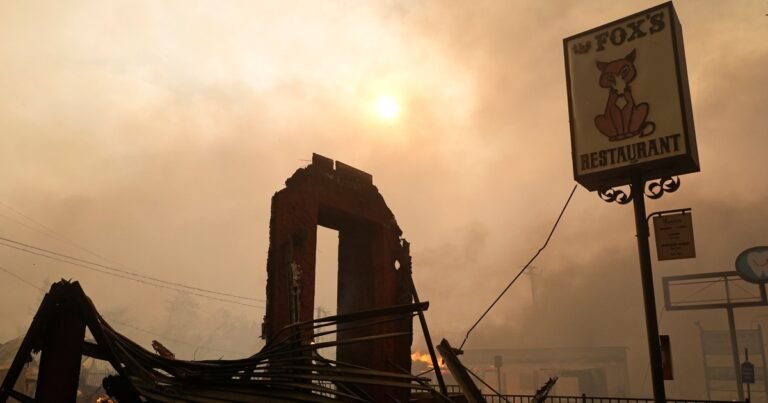Scores of restaurants, shops and community landmarks are among the 12,300 structures destroyed in the blazes still raging in Los Angeles. Many of their owners are already filing insurance claims — joining a growing number of entrepreneurs across the country who are finding out how far their coverage goes after weather-related disasters.
“We’re just kind of in this limbo until the adjusters can go and see what’s not there anymore,” said Paul Rosenbluh, co-owner and operator of Fox’s Restaurant, an Altadena diner that was consumed in the Eaton Fire.
There will be a lot of businesses that thought they had more [coverage] than they have.
Douglas Heller, director of insurance, Consumer Federation of America
Rosenbluh told NBC News days after the fire that he isn’t confident he can rebuild in the area. But once the property’s losses are accounted for, he hopes his insurer’s response will be as simple as, “Here you go, thanks, good luck moving on,” he said Thursday. His coverage includes property insurance as well as general liability insurance, which typically covers financial losses from a range of causes.
Many small-business owners could face a harsher reality, experts warn.
“I can say confidently: There will be a lot of businesses that thought they had more [coverage] than they have,” said Douglas Heller, director of insurance for the Consumer Federation of America, an advocacy group.
The insurance crisis unfolding across California is mirrored in many places nationwide, Heller said. Business owners increasingly face a patchwork of expensive coverage and overtaxed government programs struggling to fill some of the gaps, leaving many policyholders holding the bag in the end.
“Risk is increasing, and nobody wants it,” he said.
Rosenbluh and other wildfire victims may have reason for optimism, because fire damage is commonly covered in many business owners’ policies. But entrepreneurs who’ve recently weathered different types of disasters haven’t been so fortunate.
After Hurricane Helene tore through western North Carolina in October, Erin Smith, who owns Humanité Boutique in Bryson City, said she was forced to shut down for eight days after 2 inches of water filled her women’s apparel shop. Her small-business policy included general liability coverage, but she said she was shocked when her carrier informed her that it didn’t include interruption of business. For that, she would have needed flood insurance — which she didn’t realize when she signed up.
“This was my first flood,” Smith said. “No one had flood insurance.”

In an annual Allianz survey of businesses, insurance brokers and risk consultants that the financial firm released this month, climate change jumped from No. 7 last year to No. 5 among the top concerns for 2025 — its highest ranking in the survey’s 14-year history. There were 27 natural disasters that cost at least $1 billion nationwide in 2024, according to the National Oceanic and Atmospheric Administration, second only to the 28 recorded in 2023.
This was my first flood. No one had flood insurance.
Erin Smith, owner of Humanité Boutique, Bryson City, n.c.
Meanwhile, many small-business owners are paying more for policies they don’t fully understand. Premiums rose for 36% of entrepreneurs last year, J.D. Power found — more than the 34% who saw increases in 2023 — and over half of those hikes were initiated by carriers. Nearly three-quarters of small businesses surveyed by the insurer Hiscox in 2023 said they didn’t know what a business owner’s policy typically covered, while 83% couldn’t accurately describe general liability coverage.
“There are a lot of businesses, just like a lot of homeowners, who are surprised after the catastrophe strikes,” Heller said. “There may have been a broker who, four years ago, said to them, ‘Oh, you know, you can save a little money if you just get rid of this.’”
Smith is the first to admit that the fine print of business insurance “is not my expertise.” Still, she wishes her carrier had better communicated her options and plan details.
Though Smith’s boutique is up and running again, she learned this month that the flooring may need to be replaced completely — potentially costing $30,000 on top of the thousands incurred by superficial water damage, she said.
During her search for other lifelines, the Federal Emergency Management Agency directed her to apply for an economic injury disaster loan, or “EIDL,” which provides eligible businesses up to $2 million in working capital after catastrophic events, plus a year of deferred payments. But Smith said she’s still paying off earlier EIDL debt she accrued during the pandemic.
“I can’t. That just doesn’t work for me,” she said. “Fingers crossed that it’s going to be fine.”
Isaac Herrin, also in Bryson City, faced a similar dilemma when Helene destroyed over $20,000 in inventory in his retail shop, Selah Collection. Herrin, who rents the space, said he was paying for business contents insurance, a type of coverage that repairs or replaces assets. But he said his claim was denied because the shop’s landlord didn’t have flood insurance.
“I went back and I tried to argue” with the carrier, he said. “This is more than just a flood — we got hit with a hurricane in the mountains!”

Before Helene ravaged the region, insurers viewed western North Carolina as relatively low-risk. Afterward, a Reuters analysis of federal data found only 1 in 200 single-family homes in the inland area were covered by the National Flood Insurance Program despite its proximity to the Tuckasegee River, which is becoming more flood-prone as rainstorms grow more frequent.
At least a quarter of flood claims originate from non-flood-designated areas, said Janet Ruiz, a spokesperson for the Insurance Information Institute, an industry group. Extreme winter weather drives up that number as well — frozen ground doesn’t absorb water, increasing the chance of flash floods.
“Hurricane areas are only one small piece of the flood,” she said.
Heller said small-business owners need a comprehensive federal alternative to the piecemeal options currently out there. The NFIP, which covers commercial buildings and property up to $500,000 for each type of policy, has drawn scrutiny recently. Like California’s FAIR program, it has been stretched thin by increasingly volatile weather. It currently owes more than $20 billion to the U.S. government and is knocking up against its $30 billion borrowing limit. Its coverage also doesn’t include financial losses incurred by business interruption.
Project 2025, the Republican policy blueprint President-elect Donald Trump has disavowed despite his transition team tapping the initiative for staffing purposes, recommends privatizing the NFIP, putting advocates on watch as Trump takes office Monday. A spokesperson for the Trump transition team didn’t immediately respond to a request for comment.
Heller pointed to the Insure Act, a bill introduced by then-Rep. Adam Schiff, D-Calif., last year, as a model that would effectively insure the insurers, incentivizing them to assume more risk and preventing them from pulling out of disaster-prone areas. The bill has seen little movement in Congress, though, and isn’t expected to gain traction amid the coming power shift in Washington.
“We need to make sure that the government is working for businesses by making sure those products are real, quality and reasonably priced so that [insurers] can take on that risk,” Heller said. “As limited as the oversight of the homeowners insurance market is by the regulators who are supposed to protect us, it’s even less so for businesses.”

